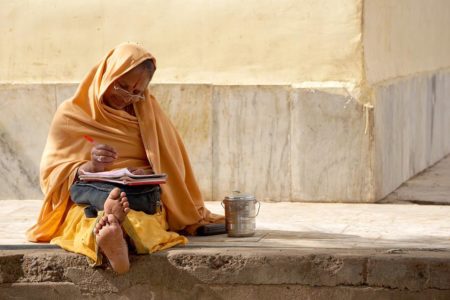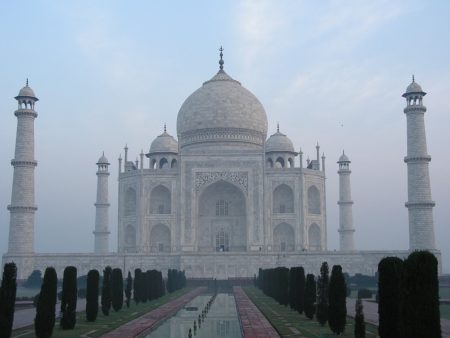When I look back on my visit to India the word that comes to mind is “sensory overload” – vivid colours, throngs of people, opulent hotels, gilded, painted temples, delicately carved marble, curries, spices, clouds of incense, vibrant life – almost too much to absorb and definitely impossible to do justice to in this short article. It is an experience similar to enjoying a delicious meal, each tasty bite to be savoured, mulled over and shared with friends. It was a wealth of experience that will take months to work through, assimilate and allow it to work its magic on me.
Life in India is lived on many, many levels, the glitzy glamour of Bollywood, wealthy merchants, civil servants with many irons in the fire, the poor desperately trying to live, the untouchables sleeping on the streets – outcasts of society, gurus and sannyasis (holy ones) guiding and controlling a people hungry for spirituality, all woven together into the rich fabric of this vast, beautiful country with an estimated population of 1 billion people.
I regarded my trip to India as a pilgrimage in search of answers to questions about Hinduism, Buddhism and Christianity and the relationship between these three spiritualities. They say that one is tested on a pilgrimage and I was indeed tested with much pain that hampered my travels and ability to experience as much as I should have been able to experience but I feel that was all part of the journey.
The trip from Mumbai Airport to our hotel took two and a half hours at two a.m.!!! The traffic was as busy then as it would have been at 2pm. India never sleeps. Some people work 18 hours a day to keep “Rotis” (bread) on the table. Six lanes of traffic become 8, with the narrowest of spaces between vehicles. Side mirrors are folded in so that cars can pass each other without touching. The maximum speed limit is 80km/h and there is almost no road rage or aggression. Drivers are relaxed and calm. You arrive when you get there and there is no possibility of getting there earlier. One of our drivers told us: “You need a good car, good reflexes, good brakes, a good hooter and good judgment to be a successful driver in India.” There are very few road accidents – the most common ones being on the highways involving long haul truck drivers due to driver fatigue.
On the highway from Dharamsala to Delhi we met two elephants ambling along in the slow lane, donkey carts, bullock carts, bicycles, tricycles, motor bikes, scooters and then the usual highway traffic. One scooter was transporting 40 stackable plastic chairs!! At times we would meet a vehicle travelling against the flow of the traffic. There was no aggression. Drivers just parted to let the vehicle through. We were told that this was the quickest way for the driver to get to his destination.
The Taj Mahal, in Agra, is a most beautiful love poem written in pink and white marble – perfect symmetry, exquisite carvings and such a peaceful place. As I sat in the beautiful gardens blue-throated green parakeets and squirrels gathered for a bite to eat thrown to them by a little old lady. You have them everywhere in the world don’t you.
McCleod Ganj, the home of the Dalai Lama, in exile, is a town situated in the foothills of the Himalayas and is surrounded by snow capped peaks. Every road either goes up or comes down a hill and the town square is tiny, occupying the only piece of level ground in the area. Tibetans in exile make up at least half of the population and the biggest Buddhist temple outside Tibet is in McCleod Ganj. “Among the gifts given by God to India, the greatest (is) seen to be that of interiority, the awareness of the presence of God dwelling in the heart of every human person and of every creature, which is fostered by prayer, meditation and contemplative silence and the practice of yoga and Sannyasa.” (Article on Saccidananda Ashram)
People walk around this town with prayer beads in hand practising the presence of God. One afternoon at the temple I watched an old woman walking around the temple for at least 4 hours praying her beads. Prayer wheels were continually set in motion by devout pilgrims hoping to gain the benefit of the prayers contained in the drums. On the second last evening of my stay in McCleod Ganj I joined the Buddhist nuns for evening prayer. About thirty nuns sat on their balcony, facing the mountains, chanting their prayers. As I sat on a nearby stone listening to them the full moon rose between two snow capped peaks – a truly profound experience.
My journey ended with a very memorable stay at Bede Griffith’s Ashram in Tamil Nadu state, South India. An Ashram is a place of retreat where one sits at the feet of a Guru (Spiritual teacher) and learns whatever lessons one needs to learn. The retreatant shares in the manual tasks of the Ashram and also attends all prayers and meditations. Saccidananda (Being Conscious Bliss) is situated amongst coconut palms and a banana plantation on the banks of the Cavery River. As the Ashram is a Christian one, run by Benedictine monks, we prayed three times a day, starting the day with meditation and Mass. Our manual labour was not too strenuous, peeling vegetables for the midday meal and keeping our rooms clean. “The aim of the ashram is to bring into our Christian Life (and Prayer) the riches of Indian spirituality, to share in that profound experience of God which originated in the Vedas, ……and has come down to us today through a continual succession of sages and holy men and women….. From this experience of God lived in the context of an authentic Christian life, it is hoped that we may be able to assist in the growth of a genuine Indian Christian liturgy and theology.” (Saccidananda article)
At the end of each time of prayer the following symbols were used that have come from Hinduism. A sandal wood paste is used to anoint the forehead and hands. Sandalwood is the most precious of all woods and is seen as a symbol of divinity. Its sweet fragrance is seen as a symbol of divine grace. This anointing represents our consecration to God and also our unconditional love of God. At midday and in the evening we anointed the forehead with vibhuti (ashes) in order to open the inner eye/third eye so that we can see with inner wisdom. The ash is also a reminder of our mortality. At the end of each of the prayers a flame was waved in a circle in front of the tabernacle. This flame manifests the hidden Christ and is passed to each person to take this light to our eyes by placing the hand over the flame and then holding the hands over our eyes. At the offertory, offerings were made of the four elements, water, earth, air and fire as an offering of all of creation to God through the Cosmic Christ. Eight flower heads were placed in specific positions on the paten symbolising the eight directions of space, placing the Mass in the centre of the universe. All these symbols brought a whole new meaning to the times of prayer and the sacrifice of the Mass, a wonderful way of bringing the whole of creation and the whole person into the presence of the Divine. The Ashram experience was very peaceful, prayerful and also answered many questions for me.
I am most grateful to my community and the Provincial Leadership Team for making this most wonderful experience possible for me.
And so the pilgrimage is over but the journey continues, the journey into the wisdom of each of the three spiritualities and in Rilke’s words the answers are in the questions.
Marilyn Brown rsm
South African Province






